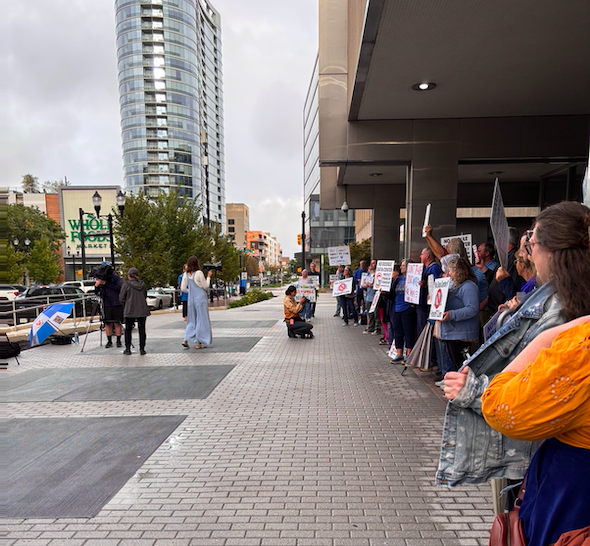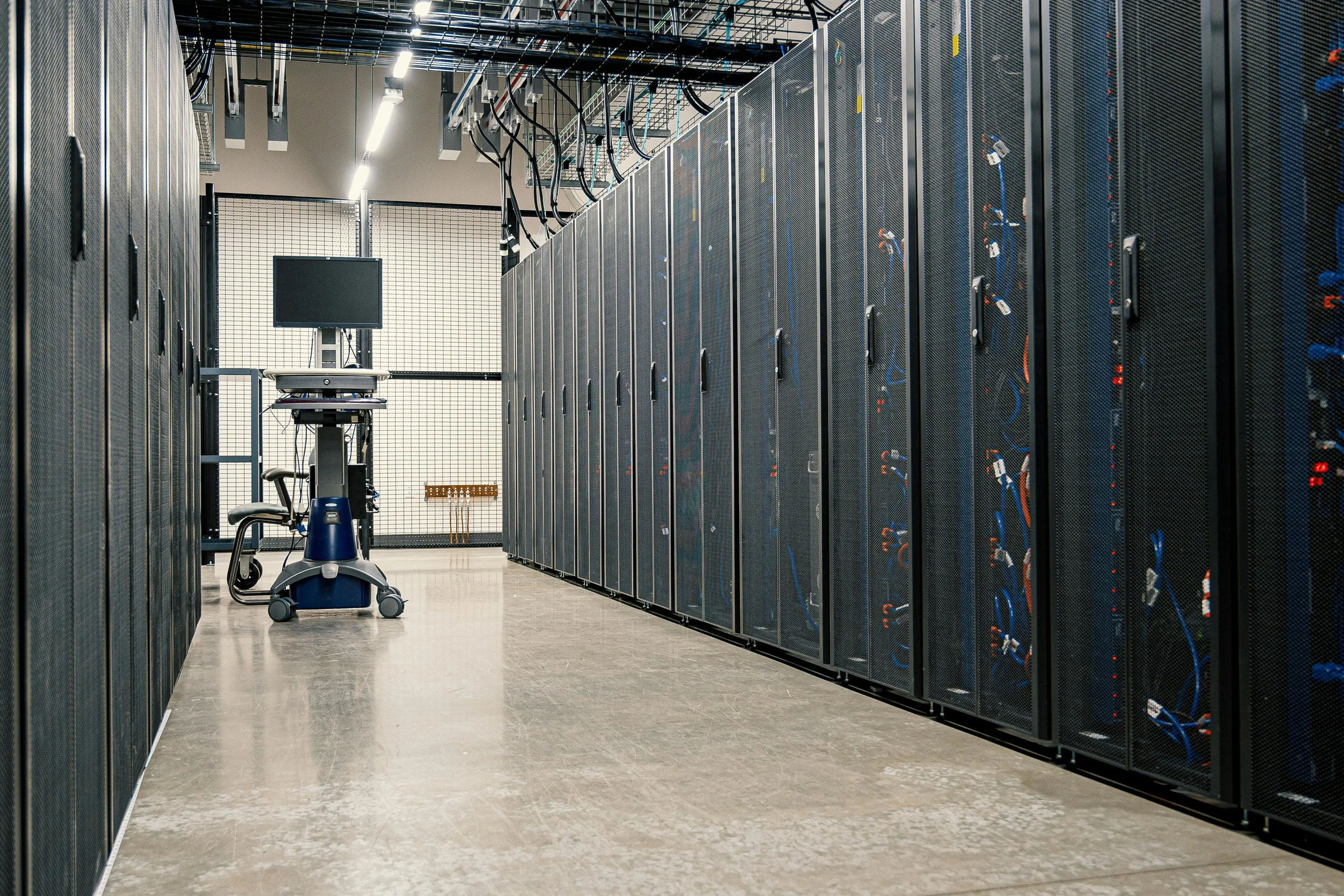Rolling the DICE on Data Center Development
By: Kevin Nichols, Earth Charter Indiana Special Projects Coordinator
Rally against a proposed data center in Indianapolis on Sept. 22, 2025. Photo by Colleen Donahoe
On the evening of September 22nd, 2025, the Indianapolis City-County Council was prepared to vote on a rezoning proposal for 468 acres of farmland to make way for a massive hyperscale data center by Google in Franklin Township. Minutes before this vote was set to take place, a lawyer for the tech giant announced the company’s decision to withdraw their proposal. The announcement was met with loud cheers and applause by the hundreds of concerned community members who attended the meeting in opposition to the proposal. This victory was the result of months of resident-led organizing to pressure council members to reject the proposal. Unfortunately, there are at least 40 data centers either under construction, or planned for development, across Indiana; all at the urging of our state and federal leaders.
I wanted to learn more about what is fueling this surge in development and the implications for our communities, so later that same week, on September 25th, 2025 I had the (self-inflicted) misfortune of attending the Midwest Data Center Investment Conference and Expo (DICE) in Chicago. I thought it would be valuable to hear directly from those who expect to benefit financially from data center construction. The impact of these facilities on the communities living in the immediate shadow has garnered significant press, but the explosion of data center development affects all of us. The associated surge in energy consumption accelerates carbon emissions in our atmosphere, at the expense of a necessary transition to renewable energy. At DICE I got some insight into how the industry rationalizes its immense energy consumption, and the business strategies that developers are using to minimize local resistance to their plans.
At around 8am, I entered a packed conference room at the Renaissance Hotel just outside the O’Hare Airport, alongside 400+ other attendees. It felt like the beginning to other conferences I’d attended. All the regular characters were there, from executives in pressed shirts and ties down to sales reps in moisture-wicking polos, smiling wide on behalf of their products and services. Sitting on the table in front of me was a bingo scorecard provided by Constellation Energy, with basic industry jargon like “critical load,” “hyperscale,” “liquid-cooling,” and “machine learning” in each box. For the next 7 hours, we sat in this one room and watched panelists rotate on and off the small stage.
The panelists represented a broad sampling of the data center industry, including construction engineering firms, surveillance and security contractors, law firms, academics, energy companies, realtors, gas turbine manufacturers, and telecommunications companies. They covered topics like site selection and development, AI integration in data center operations, and the relationship between speed and sustainability in development. The hunger for fast development was palpable, with many panelists discussing how the industry had experienced extreme growth in recent months and years.
At DICE, industry insiders discussed tactics for deceiving and manipulating communities, downplayed the environmental costs of rapid development, and peddled a fantasy that these facilities are an instrument of freedom and American dominance. Data center developers have their sights set on our communities, our water, and our energy grids, and they view our objections as inconvenient, but not roadblocks. I’ll focus on three key take-aways from this conference , which will help communities confront the sweeping threat of data center development.
1. Data centers require land, fiber internet, and A LOT of power (increasingly natural gas).
Not all data centers are created the same. Conventional data centers have been around for a long time and power much of the internet as we know it today. “The Cloud” is in fact not a cloud at all but a massive network of servers housed in data centers all over the world, humming away 24/7. Hyperscale and AI data centers require significantly more land and power. They are a relatively new phenomenon that has grown with the race to profit from AI. DICE Panelists seemed to be split, with those involved in AI development touting lofty energy-intensive developments, and those involved with conventional data center development insisting that the future of the data center landscape will require significant investment in smaller facilities as well.
Photo by Brett Sayles courtesy of pexels.com.
What developers of all sizes seemed to have in common was a shared pursuit for land with access to power and fiber internet. They frequently emphasized speed to deployment as a top priority. In many instances, data centers require more electricity than is currently available on the grid, so the drive to secure a site quickly incentivizes land acquisition before developers fully consider power generation. To compete for available power, many panelists strategized ways to ingratiate themselves with utility companies and local government leaders who can ease regulatory hurdles. What does this mean in practice? Increased use of nonrenewable fossil fuels, largely natural gas. Burning fossil fuels creates greenhouse gas pollution and speeds the effects of human-caused climate change, whether generated directly by a power company or onsite behind the gates of a private operation.
2. Developers know that data centers are environmentally unsustainable.
Every mention of sustainability at the DICE conference seemed anchored in an unspoken understanding that the projects being discussed are presently unsustainable, if not just because of the sheer amount of power required to keep them online. Some panelists went further, even acknowledging that sustainability had taken a backseat in recent development efforts. Others spoke openly about the incompatibility of data center development with the transition to renewables. Environmentalists are seen as an enemy of the industry because of this. Speakers acknowledged discomfort with the recent press about water usage in data centers, pointing to closed-loop cooling systems and conventional HVAC systems as alternatives, but stopping short of suggesting any industry-wide response or action.
Most panelists seemed to be in agreement that the future of data center power was in nuclear energy, but the only estimate I heard for when this technology might be practicable was 18-20 years. Until then, any new data center must rely on the power grid or onsite fossil fuel power generation. You may see renewables incorporated into data center design, but even data center developers acknowledge that these PR stunts can only generate a small fraction of the power needed. Solar arrays might look great next to data centers, but the energy demands are just too vast. Any incorporation of renewables is just for show. Data center growth is dependent on fossil fuels, or maybe speculative nuclear innovations that may never come.
3. Data center developers are terrified of community pushback.
Perhaps the most alarming trend I observed at DICE was seeing data center developers talk with open disdain for the communities in which they situate their buildings. Developers use terms like “community-challenged” to discuss the broad public opposition to their facilities. Panelists suggested using shell companies when entering a market to avoid scrutiny, paying off neighbors of proposed data centers, working with local government to relegate protesters in out-of-sight staging areas, and facilitating youth programming/propaganda to normalize data centers in adjacent communities.
One phrase I heard a lot at DICE was “mission critical,” a term meant to evoke the military, where development and operations must be secured at all costs.This term is used to justify hasty site selection and design, and the mindset that all of this is worth the cost of unsustainable un-checked fossil fuel consumption. The reigning attitude of data center developers is “If only the uneducated masses could understand that data centers are necessary for our freedom, they’d allow developers to run roughshod over their communities and planet.” Some took the military association more literally than others, when one panelist openly described applying counterinsurgency tactics he learned in active duty military service, like going undercover in bars and churches to gauge a community’s potential for resistance to a data center development.
What all of this tells me is that community pushback has the power to either halt or slow development, as was the case in Indianapolis. Companies are aware that they have a PR crisis on their hands, but they are hoping that early planning and spy tactics will be enough to keep criticism at bay.
Conclusion
We know that unchecked data center development hurts surrounding communities and obliterates our climate goals. The individuals behind this industry speak of themselves more like an occupying military force than neighbors in our communities. They are all-too happy to build in historic sacrifice zones where environmental degradation and public health have always taken a backseat to industrial development. For a data center developer, people just get in the way of business.
It may all be for nothing too, since commercial products built on large language models have yet to yield any significant profit for the companies developing them. It’s very possible that these hyperscale data centers will be abandoned when the AI bubble bursts, similar to the blight of abandoned retail spaces we currently see all over this country.
I set out on this journey to expose insider information from the DICE conference, and walked away surprisingly optimistic about the power of community resistance to these facilities. Google’s decision to pull out of Franklin Township showed me that public pressure, even against a tech behemoth is effective. The fear in the eyes of data center developers as they spoke of protestors and activists only reinforced that. Though development is already underway on many of these projects, confronting new proposals with organized protest and vocal public opposition is the best way to slow this industry down.



